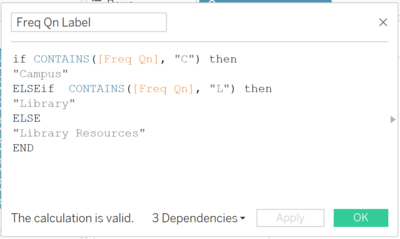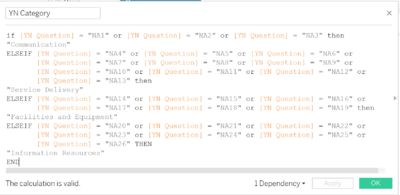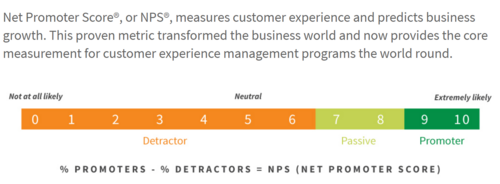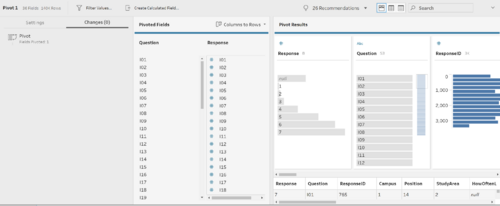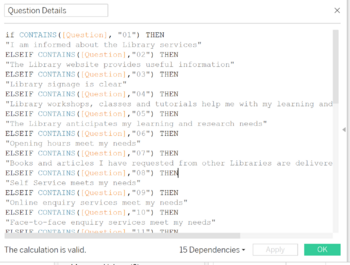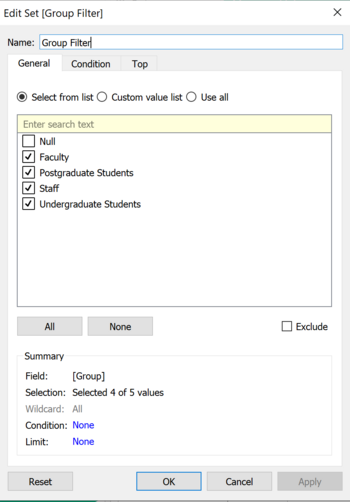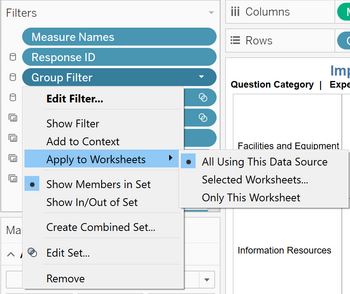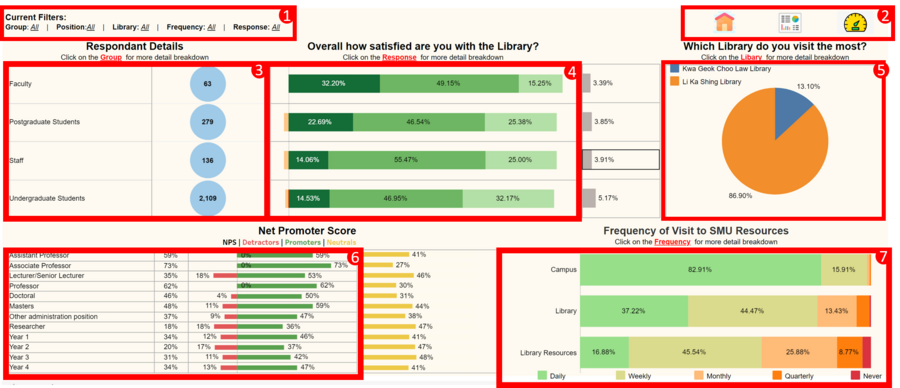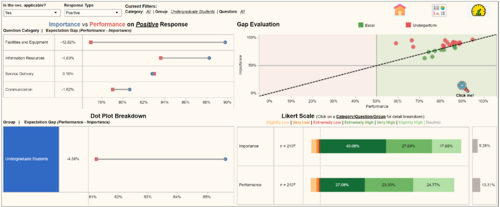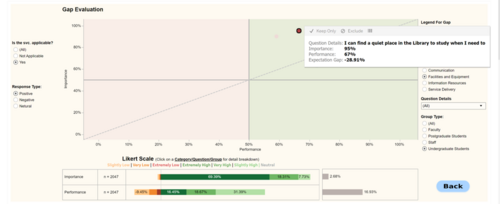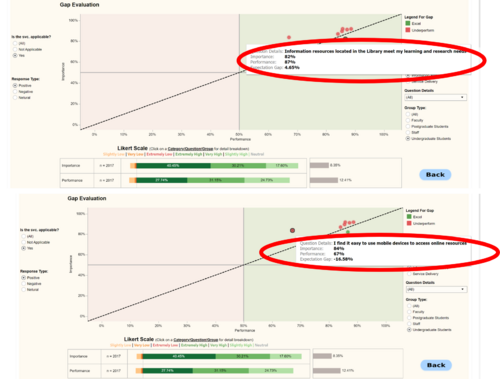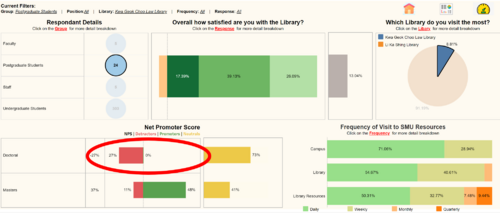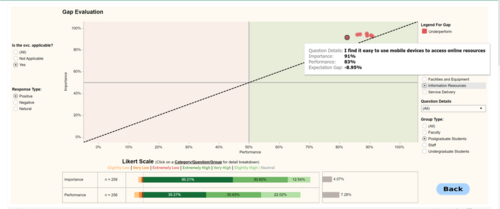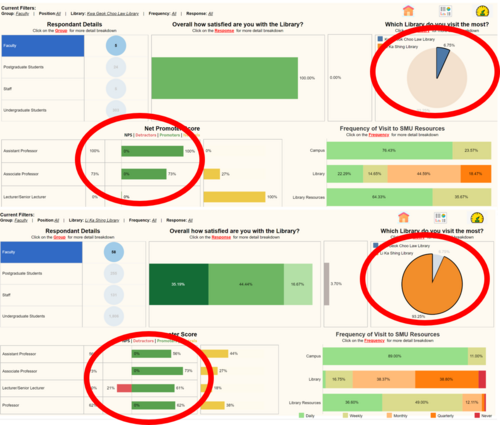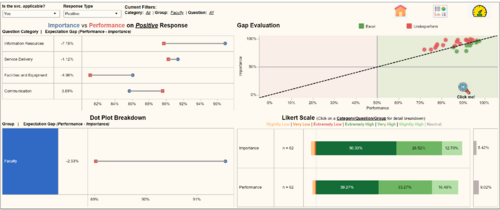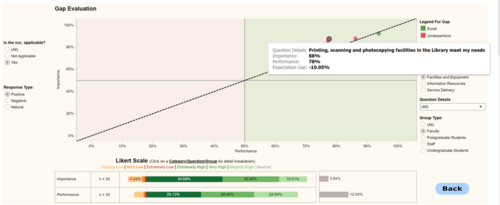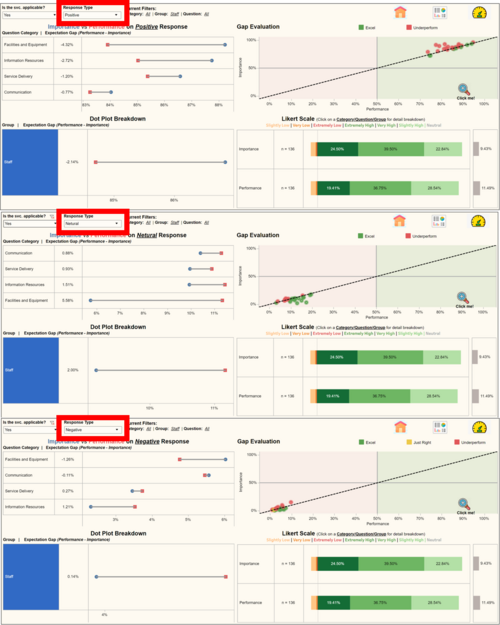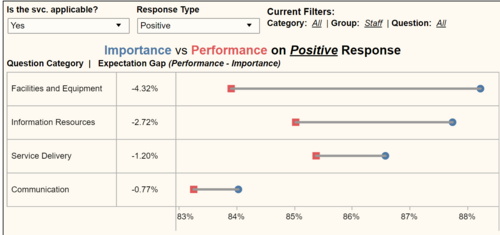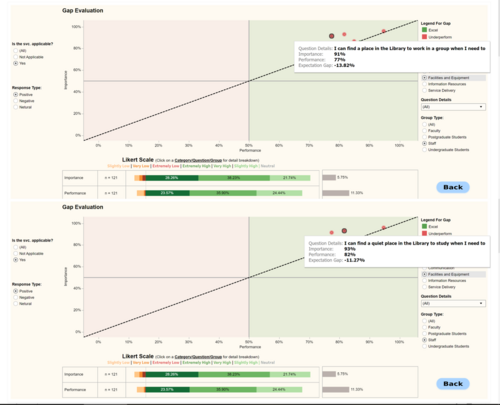Difference between revisions of "IS428 AY2019-20T2 Assign GUO LINGXING"
Lxguo.2017 (talk | contribs) |
Lxguo.2017 (talk | contribs) |
||
| (32 intermediate revisions by the same user not shown) | |||
| Line 37: | Line 37: | ||
[[File:NA qn label.png|400px|center|NA label]] | [[File:NA qn label.png|400px|center|NA label]] | ||
<li> Net Promoter Score (NPS) Question </li> | <li> Net Promoter Score (NPS) Question </li> | ||
| + | [[File:NPS1.2.png|500px|center]] | ||
</ol> | </ol> | ||
===Fixing the "Fat and short" data table problem=== | ===Fixing the "Fat and short" data table problem=== | ||
| Line 170: | Line 171: | ||
Using the dashboard as a platform for investigation and analysis, we wish to help the SMU library managements to find out service satisfaction across the different user groups. | Using the dashboard as a platform for investigation and analysis, we wish to help the SMU library managements to find out service satisfaction across the different user groups. | ||
=== Undergraduate Students === | === Undergraduate Students === | ||
| − | + | Overall, there are 2,109 undergraduate respondents, which formed the largest user respondent group in the 2018 SMU Library service survey (81.52%), and at least 83% of the library user (among the undergraduate students) for each study year are satisfied with the libraries' performance and 5-7% of them are dissatisfied with the libraries' performance. Majority of the undergraduate students, 85.69%, uses Li Ka Shing Library (LKSL) most while 14.31% of the students use Kwa Geok Choo Law Library. More than 90% of the respondents who used LKSL more frequently are from Accountancy, Information System, Social Sciences and Economics, while most 47.77% who used Kwa Geok Choo Law Library more frequently are from School of Law. | |
| − | + | ||
''' Insights & Discovery 1: ''' <br> | ''' Insights & Discovery 1: ''' <br> | ||
[[File:Ug insight 1.png|500px|]] [[File:Ug insight1.1.png|400px]] <br> | [[File:Ug insight 1.png|500px|]] [[File:Ug insight1.1.png|400px]] <br> | ||
| − | Based on our visual dashboard, we can see that | + | Based on our visual dashboard, we can see that as the seniority of the student increase, there is a decreasing trend in the visits to the SMU libraries and an increasing trend in usage of library resources such as online articles, databases, ebooks. This can help our Library managements to adjust and better utilize their resources while planning for library development. Also, there is a spike in Year 2's detractors and a decrease in the number of Promoters. Upon digging further, we realised that the main unhappiness comes from undergraduate students that visited the SMU Law library. |
''' Insights & Discovery 2: ''' <br> | ''' Insights & Discovery 2: ''' <br> | ||
| Line 182: | Line 183: | ||
''' Insights & Discovery 3: ''' <br> | ''' Insights & Discovery 3: ''' <br> | ||
[[File:Ug insight 3.png|500px|center]] | [[File:Ug insight 3.png|500px|center]] | ||
| − | From the dashboard above, out of the 4 service categories the SMU library provides, 3 of the categories failed to meet the expectation. | + | From the dashboard above, out of the 4 service categories the SMU library provides, 3 of the categories failed to meet the expectation. For all service applicable to the respondents, with positive responses (at least a score of 5 out of 7 in a scale), the Facilities and Equipment have a negative gap score of 12.82% when comparing performance to importance. The students are satisfied with the Service and Delivery category with a performance score higher than importance overall at 0.19%. |
[[File:Ug insight 3.2.png|500px|center]] | [[File:Ug insight 3.2.png|500px|center]] | ||
| Line 198: | Line 199: | ||
=== Postgraduate Students === | === Postgraduate Students === | ||
| + | Postgraduate Students consist of Doctoral and Masters student. Among the 279 valid respondents, we used in our visual dashboards, more than half of the respondents come from Business. Majority of the postgraduate students, 91.19%, uses Li Ka Shing Library most while only 8.81% of uses Kwa Geok Choo Law Library. All the respondents from Information System, Economics faculty uses the Li Ka Shing library most, while law students uses Kwa Geok Choo Law Library most. | ||
| + | |||
| + | ''' Insights & Discovery 1: ''' <br> | ||
| + | [[File:Pg insight 1.png|500px|center]] | ||
| + | |||
| + | Surprisingly all the respondents, who are attained Doctoral, that patronize SMU Law library most frequently shows a strong sense of dissatisfaction. With 0% and 27% Dectroators and 73% Naturals, the Law library needs to have a coffee with these group of students to understand why the students are so unlikely to recommend the libraries to others. | ||
| + | [[File:Pg insight 1.2.png|500px|center]] | ||
| + | The result for LKS library is much better. Close to half of the postgraduates are strong Promoters for the LKS library. This shows that even for students who are pursuing further studies after their Bachelor's Degree, SMU LKS library is still capable of providing adequate resources and service for them. | ||
| + | |||
| + | ''' Insights & Discovery 2: ''' <br> | ||
| + | [[File:Pg insight 2.png|500px|center]] | ||
| + | Interestingly, when we filter the postgraduates based on their response to the survey in Negative(1 to 3), Positive (5 to 7) and Neutral (4), we will realise that, for those who perceived low importance (Negative or Neutral in this case) in library services, most of the performances of the services perform better than its perceived importance. From the image above, we can see that for respondents with a neutral or negative response, the service gap is positive (performance doing better than perceived importance). Whereas on the other hand, when the postgraduates have high importance expectation in library services, the performance falls short behind the importance in all the service category. | ||
| + | |||
| + | ''' Insights & Discovery 3: ''' <br> | ||
| + | [[File:Pg insight 3.png|500px|center]][[File:Pg insight 3.1.png|500px|center]] | ||
| + | Similar to undergraduates students, the postgraduate student post great emphasis on space and quiet environment in their importance in library services. However, we can see that the overall performance deteriorates. The findings emphasis on the poor performance in the mobile devices to access the library resource. As postgraduate students (masters and above )are mostly students that working adults, they are unlikely to have the spare time to travel to SMU for library resource hence this reflects the need for SMU library's to broaden their effort in providing a mobile-friendly environment for library resources. | ||
| + | |||
| + | ''' Insights & Discovery 4: ''' <br> | ||
| + | [[File:Pg insight 4.png|500px|center]] | ||
| + | From the snaps we took from the dashboard, we can see that the postgraduates are generally not very satisfied with the Sevice Delivery. Most of the postgraduates are working adults and can only access the library after their working hours, timing where most library staff will not be around/ about to end work. Furthermore, by the time they reach the library most of the items would have been accessed by multiple students which resulted in the item, not in the expected shelf. As a result, they will not be able to get the best services from the library. To serve the postgraduates better, SMU library can arrange staggered timetables for the library staffs (start late and end later) to cater to the needs of postgraduates student. Also, moving towards E-library will help to overcome all these challenges. | ||
=== Faculty === | === Faculty === | ||
| + | Calculations are done based on service applicable to the respondent. | ||
| + | |||
| + | ''' Insights & Discovery 1: ''' <br> | ||
| + | [[File:F insight 1.png|500px|center]] | ||
| + | Majority of the faculties, 93.25%, uses Li Ka Shing Library most while only 6.75% of uses Kwa Geok Choo Law Library. The largest group, 28.57% of the respondents, are from the business faculty. Faculty group is the only user group that has no negative response (scale rating 3 and below) for the overall library service satisfaction. Among the Faculty group, Lecturer/Senior Lecturer is the only subgroup that has Detractors while the remaining subgroups have an NPS score of 59 and above. | ||
| + | |||
| + | ''' Insights & Discovery 2: ''' <br> | ||
| + | [[File:F insight 2.1.png|500px|center]] | ||
| + | It is observed that Kwa Geok Choo Law Library has 0 Detractors among the Faculty group with 100% Promoters among Assistant Professors, 73% among Associate Professor and 100% Neutrals. | ||
| + | |||
| + | ''' Insights & Discovery 3: ''' <br> | ||
| + | [[File:F insight 3.png|500px|center]] | ||
| + | It is observed that faculty is most satisfied with the "Communication" service provided by the libraries, with a 3.89% performance higher than importance. The remaining services have lower performance than importance. Information Resources has the biggest expectation gap with -7.19% performance behind importance. Followed by Facilities and Equipment where performance is behind importance by -4.98%. Last but not least, Service Delivery has an expectation gap of -1.12%. | ||
| + | [[File:F insight 3.1.png|500px|center]] | ||
| + | In Information and Resources, the biggest concern (-16.18% expectation gap) was the information resource located in the library not able to meet the learning and research needs. Followed by the library search engine's capability in finding relevant resources with an expectation gap of -10.64%. Therefore for the library to provide adequate service to cater to the needs of our Faculties, library need needs to expand its collection of resources. Since the library is already having challenges to provide more spaces for its users to do work, the library can expand the databases in its e-platform to empower its search engine's capability. Some market survey will be required to understand what kind of database is in need before the acquisition. | ||
| + | |||
| + | ''' Insights & Discovery 4: ''' <br> | ||
| + | [[File:F insight 4.png|500px|center]] | ||
| + | Unlike other user groups, the biggest issue for Facilities and Equipment for the Faculty group are the printing, scanning and photocopying facilities in the library and not space/quiet environment problem. This is most likely because every faculty has their own office room and access to private rooms, hence despite they are still unsatisfied with space and quiet environment in the library, the printing facilities posed a greater concern for them. | ||
=== Staff === | === Staff === | ||
| + | <p>Overall, there are 136 staff respondents and at least 85% of the staffs are satisfied with the libraries' performance and around 4% of them are dissatisfied with the libraries' performance. 96.23% of the staff uses Li Ka Shing Library most frequently and only 3.77% of them use Kwa Geok Choo Law Library.</p> | ||
| + | ''' Insights & Discovery 1: ''' <br> | ||
| + | [[File:S insights 1.png|500px|center]] | ||
| + | Base on the 5 respondents' response, the visual reveals that researches do not visit Law library often. Also, among the other administration staff who patronize the law library frequently, they displayed great satisfaction towards overall library services (100% in both extremely high and very high). Research staffs have the most library detractors among the staff user group, 18% of them are detractors. On the other hand, Administration staffs are more likely to be a promoter, almost 1 in 2 staffs are promoters for all the libraries. | ||
| + | |||
| + | ''' Insights & Discovery 2: ''' <br> | ||
| + | [[File:S insights 2.png|500px|center]] | ||
| + | After looking through all the positive, neutral and negative response type, the visual reveal that staff respondents with neutral response have an overall of 2% performance higher than importance and those with negative response have an overall of 0.14% performance higher than importance. This is mostly because of the low expectations they have and hence, easier for the library to meet their expectation (importance). On the other hand, staff who have great expectation on the library services, there is a gap of -2.14% in performance when compared to importance. | ||
| + | |||
| + | |||
| + | ''' Insights & Discovery 3: ''' <br> | ||
| + | [[File:S insights 3.png|500px|center]] | ||
| + | Among all the positive applicable services response (at least a score of 5 out of 7 in a scale), Communication is the best performing category as it has the least negative gap of 0.77% overall. Facilities and equipment are the worst-performing categories with a gap score of -4.32% when comparing performance to importance. | ||
| + | [[File:S insights 3.1.png|500px|center]] | ||
| + | When we look deeper into the worst-performing category, Facilities and equipment, we will realise that the 2 main negative gap contributor comes from space to work and quiet space in the library. Similar to the feedbacks from postgraduates and undergraduates, SMU staffs are also having challenges in finding a quiet space to work in SMU libraries. | ||
== Reference == | == Reference == | ||
| Line 208: | Line 263: | ||
:* Likert scale: https://www.datarevelations.com/resources/got-likert-data-neutrals/ | :* Likert scale: https://www.datarevelations.com/resources/got-likert-data-neutrals/ | ||
:* Dot plots: https://www.datarevelations.com/resources/importancesatisfaction/ | :* Dot plots: https://www.datarevelations.com/resources/importancesatisfaction/ | ||
| + | :* NPS: https://www.netpromoter.com/know/ | ||
== Comments == | == Comments == | ||
Latest revision as of 22:59, 15 March 2020
Contents
Problem & Motivation
SMU Libraries conduct a comprehensive survey in which faculty, students and staff have the opportunity to rate various aspects of SMU library's services. The survey provides SMU libraries with input to help enhance existing services and to anticipate emerging needs of SMU faculty, students and staff. However, despite all the efforts in developing the surveys, the past reports were too primitive and difficult to gather high-level insights. Hence a more interactive dashboard visualisation is needed to help the management to understand how well the library has been serving the SMU community.
We will be using visual analytics approach to reveal the level of services provided by SMU libraries as perceived by:
- the undergraduate students,
- the postgraduate students,
- the faculty,
- the staff.
Dataset Analysis & Transformation Process
This section will elaborate on the dataset analysis and transformation process for each dataset in order to prepare the data for import and analysis on interactive visualization. There's one excel file provided which contains 2 sheets:
- Sheet 1: SMU
- Sheet 2: Legend
SMU sheet contains all the data that were recorded in 2018. Legend Sheet contains all the legends for all the values in each column in the SMU sheet. Generally, we can breakdown the dataset into 2 broad categories, Respondent Characteristic categories, Question categories.
For Respondent Characteristic' categories we have:
- Campus
- StudyArea
- Position
- Response ID
For Question categories, we can further break it down into 4 different categories:
- Importance and Performance Question*, which consists of 4 categories (5 for performance):
- Communication
- Service Delivery
- Facilities and Equipment
- Information Resources
- Overall Satisfaction (Only applicable to performance)
- Frequency of the Library Resource Usage Question*, which contains questions that query the respondents the number of usage/access towards library resources.
- Is the service applicable to the surveyee (NA) Question*, which questions the respondents if the services in importance/performance are applicable to them.
- Net Promoter Score (NPS) Question
Fixing the "Fat and short" data table problem
The datasheet (SMU) is challenging to interpret for both human eyes and machine to process. Therefore, we need to preprocess and massage the data before we design and visual.
Issue: Dataset is "fat and short", in other words, not machine friendly. As the raw data have not been processed the two broad categories, respondent characteristics and question category, are not properly segregated; bad data structure to feed into the machine for analytics. Therefore, the records will be unmanageable for the machine to process and create challenges for us as we are developing the visuals. Hence, we need to slim it down (reshape) into "tall and long" data structure so that we can do proper calculations within our analytic tools.
Solution: Pivot and Pivot. Since we need certain fields to help us to identify our records, we will not touch the respondent characteristics fields and keep it as it is for now. However, we need to do some processing with the question categories using Tableau Prep Builder.
- Upload the data into Tableau Prep Builder, remove fields that we will not be working on.
- Pivot the columns that belong to the 3 question categories we have identified earlier (Question category with *).
- We will pivot the fields that fall under Importance and Performance (inclusive of p27).
- Create a new step in tableau prep for the remaining question categories, except NPS question as it only has a single field. (Single fields are not required to pivot.)
- Save the flow and output the processed result and the data will be ready for tableau!
Further data cleaning
In the previous steps, we have done the basic cleaning and processing. Before we proceed further, we need to identify and filter out only relevant records. To achieve this, we need to establish the relationships between our features and create necessary calculated fields.
Issue: Dimensions are in the raw form and has no much meaning/relationship. More high-level dimensions are needed.
Solution: Make use of calculated fields to create high-level dimensions and group relevant data records for better manipulations.
- Generate labels (alias) for the dimensions using calculated fields to create label (meaning) for the data.
- Use Calculated fields to form relationship between data.
- Repeat these steps until we are able to establish a hierarchy of the relationship among the data we identified in section 1 (Question categories)
- Once all the necessary dimensions are established, we will need to filter data that is not within our interest before we build our visual dashboards. We can do so by utilising the combinations of the filter and set functions in Tableau to filtered records that are NULL after our previous steps from our display/future calculation.
- Previously, we created a calculated field to categorise the respondents from positions (e.g.Year 1 student) into user group category (e.g. Undergraduate Student). As a result, there will be a NULL label for those positions that did not get categorized in our define calculated field. Therefore, we will want to exclude these records from our future calculations. To achieve this, we can create a Set to define the values of interest within the dimension.
- Once we created the set, place it into the filters shelf and set the set filter to apply to all worksheets. This will help us to ensure our calculation's consistency throughout our worksheets and dashboards.
- Repeat the previous steps for all the necessary dimensions that we can keep it consistent throughout dashboards. Besides, we can also make use of the "apply to selected worksheets" option if we wish to keep constant records for certain worksheets/dashboard only.
Interactive Visualization
The interactive visualization can be accessed here: https://public.tableau.com/profile/lingxing7291#!/vizhome/SMUSurveyDashboard2018/HomePage?publish=yes
There were several considerations exercised while designing the visual dashboard to ensure a nice balance between functionality and usability for our users. Below are some of the implementations to make the dashboard user-friendly, and at the same time, provide high-grade functionalities that empower users for in-depth analysis.
Dashboard: Service Importance vs Service Performance
- Multiple filters can be applied at the same time!
| Bubble | Purpose | Description |
|---|---|---|
| 1 | Filter | Segments the surveyee into 2 collections: Those that are aware of the service library offers and those who consider the services as not applicable to them. Selecting all will display the whole valid respondent records. Changing the values will filter the data used for the remaining calculation for the charts in the dashboard. |
| 2 | Filter | Segments the surveyee into 3 collections: those responses that are positive (5 to 7 in scale), negative (1 to 3 in scale) and neutral (4 in scale). Changing the values will filter the data used for the remaining calculation for the charts in the dashboard. |
| 3 | Status board | Its purpose is to display all the filters applied so that users can make immediate reference to what the visuals are displaying. |
| 4 | Navigation bar | Allow users to access to different dashboards for analysis. |
| 5 | Interactive chart with filtering functions | By clicking on the fields within the table, the dashboard will change to visual of the selected Question Category. |
| 6 | Gap evaluation chart with filtering functions | Each circle represents the performance gap of a survey question. The circles are clickable and it works as a question filter. When selected, the dashboard will change to visual of the respective Question. The red star beside the magnifying glass is a navigation button that directs users to another dashboard. When clicked, it will bring the user to a zoom-in version of the chart as I understand that due to the inadequate space, the charts and shapes are compact and a little difficult for users to select the desire question. Hence, a larger dashboard that will help the users to overcome these struggles. |
| 7 | Interactive chart with filtering functions | By clicking on the fields within the table, the dashboard will change to visual of the selected User Group. |
| 8 | Legend for the Likert scale chart | Its purpose is to overcome the space constrain challenge. |
| 9 | User tips | This line serves as a short user manual for the dashboard in handling the dashboard. |
Dashboard: Satisfaction Analysis
- Multiple filters can be applied at the same time!
| Bubble | Purpose | Description |
|---|---|---|
| 1 | Status board | Its purpose is to display all the filters applied so that users can make immediate reference to what the visuals are displaying. |
| 2 | Navigation bar | Allow users to switch between dashboards for different analysis. |
| 3 | Interactive chart with filtering functions | By clicking on the fields within the table, the dashboard will change to visual of the selected User group. |
| 4 | Interactive chart with filtering functions | By clicking on the fields within the table, the dashboard will change to visual of the selected Reponse within the respective User group . |
| 5 | Interactive chart with filtering functions | By clicking on the fields within the table, the dashboard will change to visual of the selected Library. |
| 6 | Interactive chart with filtering functions | By clicking on the fields within the table, the dashboard will change to visual of the selected NPS role (Dectractor/Promoter) in Position. |
| 7 | Interactive chart with filtering functions | By clicking on the fields within the table, the dashboard will change to visual of the selected Frequency. |
Analysis & Insights
Using the dashboard as a platform for investigation and analysis, we wish to help the SMU library managements to find out service satisfaction across the different user groups.
Undergraduate Students
Overall, there are 2,109 undergraduate respondents, which formed the largest user respondent group in the 2018 SMU Library service survey (81.52%), and at least 83% of the library user (among the undergraduate students) for each study year are satisfied with the libraries' performance and 5-7% of them are dissatisfied with the libraries' performance. Majority of the undergraduate students, 85.69%, uses Li Ka Shing Library (LKSL) most while 14.31% of the students use Kwa Geok Choo Law Library. More than 90% of the respondents who used LKSL more frequently are from Accountancy, Information System, Social Sciences and Economics, while most 47.77% who used Kwa Geok Choo Law Library more frequently are from School of Law.
Insights & Discovery 1:

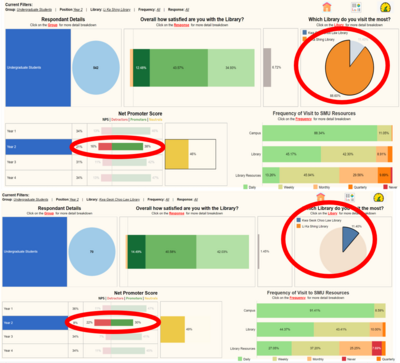
Based on our visual dashboard, we can see that as the seniority of the student increase, there is a decreasing trend in the visits to the SMU libraries and an increasing trend in usage of library resources such as online articles, databases, ebooks. This can help our Library managements to adjust and better utilize their resources while planning for library development. Also, there is a spike in Year 2's detractors and a decrease in the number of Promoters. Upon digging further, we realised that the main unhappiness comes from undergraduate students that visited the SMU Law library.
Insights & Discovery 2:
Among the undergraduate students who visit the Law library the most, students from Law school has the highest level of dissatisfaction and will go around the bad mouth of the library, the library should conduct in-depth interviews to gain better insights.
Insights & Discovery 3:
From the dashboard above, out of the 4 service categories the SMU library provides, 3 of the categories failed to meet the expectation. For all service applicable to the respondents, with positive responses (at least a score of 5 out of 7 in a scale), the Facilities and Equipment have a negative gap score of 12.82% when comparing performance to importance. The students are satisfied with the Service and Delivery category with a performance score higher than importance overall at 0.19%.
The main reason why undergraduate students are feeling inadequate performance is due to the overcrowding library space. This finding proposes that our library need to enforce in the seat hogging policy to ensure the students can find seats for their group projects.
Interestingly, the SMU Library provides plenty of computers for the students but the importance of having computers in the library is relatively low (SMU student will have their laptop most of the time). This then suggests that the library can better utilize the space by reducing the number of computers to provide more space for group work as the students set higher importance in having space over the computers.
Besides, due to the overcrowding issue in library space, the response from the undergraduate student for quiet ambient is alarming. Hence, the library can reduce computer areas and create more study areas. The money saved from reducing the number of computers can be used to bring in more soundproof divider wall to reduce the level of noise inside the library areas.
Insights & Discovery 4:
For Information Resources, Undergraduate students are very satisfied with the resources located within the library to meet their learning needs. However, there are serval complaints regarding online information resources when the student wishes to access the resources outside of the library (virtually). The mobile version of library resources performed poorly (-16.58% in performance gap). Most, if not all, of the services in red circles are related to online resources. This finding suggests that our library need to slow down the effort in bringing in more physical resources to the library and allocate more resources into developing the e-library (online) environment.
Postgraduate Students
Postgraduate Students consist of Doctoral and Masters student. Among the 279 valid respondents, we used in our visual dashboards, more than half of the respondents come from Business. Majority of the postgraduate students, 91.19%, uses Li Ka Shing Library most while only 8.81% of uses Kwa Geok Choo Law Library. All the respondents from Information System, Economics faculty uses the Li Ka Shing library most, while law students uses Kwa Geok Choo Law Library most.
Insights & Discovery 1:
Surprisingly all the respondents, who are attained Doctoral, that patronize SMU Law library most frequently shows a strong sense of dissatisfaction. With 0% and 27% Dectroators and 73% Naturals, the Law library needs to have a coffee with these group of students to understand why the students are so unlikely to recommend the libraries to others.
The result for LKS library is much better. Close to half of the postgraduates are strong Promoters for the LKS library. This shows that even for students who are pursuing further studies after their Bachelor's Degree, SMU LKS library is still capable of providing adequate resources and service for them.
Insights & Discovery 2:
Interestingly, when we filter the postgraduates based on their response to the survey in Negative(1 to 3), Positive (5 to 7) and Neutral (4), we will realise that, for those who perceived low importance (Negative or Neutral in this case) in library services, most of the performances of the services perform better than its perceived importance. From the image above, we can see that for respondents with a neutral or negative response, the service gap is positive (performance doing better than perceived importance). Whereas on the other hand, when the postgraduates have high importance expectation in library services, the performance falls short behind the importance in all the service category.
Insights & Discovery 3:
Similar to undergraduates students, the postgraduate student post great emphasis on space and quiet environment in their importance in library services. However, we can see that the overall performance deteriorates. The findings emphasis on the poor performance in the mobile devices to access the library resource. As postgraduate students (masters and above )are mostly students that working adults, they are unlikely to have the spare time to travel to SMU for library resource hence this reflects the need for SMU library's to broaden their effort in providing a mobile-friendly environment for library resources.
Insights & Discovery 4:
From the snaps we took from the dashboard, we can see that the postgraduates are generally not very satisfied with the Sevice Delivery. Most of the postgraduates are working adults and can only access the library after their working hours, timing where most library staff will not be around/ about to end work. Furthermore, by the time they reach the library most of the items would have been accessed by multiple students which resulted in the item, not in the expected shelf. As a result, they will not be able to get the best services from the library. To serve the postgraduates better, SMU library can arrange staggered timetables for the library staffs (start late and end later) to cater to the needs of postgraduates student. Also, moving towards E-library will help to overcome all these challenges.
Faculty
Calculations are done based on service applicable to the respondent.
Insights & Discovery 1:
Majority of the faculties, 93.25%, uses Li Ka Shing Library most while only 6.75% of uses Kwa Geok Choo Law Library. The largest group, 28.57% of the respondents, are from the business faculty. Faculty group is the only user group that has no negative response (scale rating 3 and below) for the overall library service satisfaction. Among the Faculty group, Lecturer/Senior Lecturer is the only subgroup that has Detractors while the remaining subgroups have an NPS score of 59 and above.
Insights & Discovery 2:
It is observed that Kwa Geok Choo Law Library has 0 Detractors among the Faculty group with 100% Promoters among Assistant Professors, 73% among Associate Professor and 100% Neutrals.
Insights & Discovery 3:
It is observed that faculty is most satisfied with the "Communication" service provided by the libraries, with a 3.89% performance higher than importance. The remaining services have lower performance than importance. Information Resources has the biggest expectation gap with -7.19% performance behind importance. Followed by Facilities and Equipment where performance is behind importance by -4.98%. Last but not least, Service Delivery has an expectation gap of -1.12%.
In Information and Resources, the biggest concern (-16.18% expectation gap) was the information resource located in the library not able to meet the learning and research needs. Followed by the library search engine's capability in finding relevant resources with an expectation gap of -10.64%. Therefore for the library to provide adequate service to cater to the needs of our Faculties, library need needs to expand its collection of resources. Since the library is already having challenges to provide more spaces for its users to do work, the library can expand the databases in its e-platform to empower its search engine's capability. Some market survey will be required to understand what kind of database is in need before the acquisition.
Insights & Discovery 4:
Unlike other user groups, the biggest issue for Facilities and Equipment for the Faculty group are the printing, scanning and photocopying facilities in the library and not space/quiet environment problem. This is most likely because every faculty has their own office room and access to private rooms, hence despite they are still unsatisfied with space and quiet environment in the library, the printing facilities posed a greater concern for them.
Staff
Overall, there are 136 staff respondents and at least 85% of the staffs are satisfied with the libraries' performance and around 4% of them are dissatisfied with the libraries' performance. 96.23% of the staff uses Li Ka Shing Library most frequently and only 3.77% of them use Kwa Geok Choo Law Library.
Insights & Discovery 1:
Base on the 5 respondents' response, the visual reveals that researches do not visit Law library often. Also, among the other administration staff who patronize the law library frequently, they displayed great satisfaction towards overall library services (100% in both extremely high and very high). Research staffs have the most library detractors among the staff user group, 18% of them are detractors. On the other hand, Administration staffs are more likely to be a promoter, almost 1 in 2 staffs are promoters for all the libraries.
Insights & Discovery 2:
After looking through all the positive, neutral and negative response type, the visual reveal that staff respondents with neutral response have an overall of 2% performance higher than importance and those with negative response have an overall of 0.14% performance higher than importance. This is mostly because of the low expectations they have and hence, easier for the library to meet their expectation (importance). On the other hand, staff who have great expectation on the library services, there is a gap of -2.14% in performance when compared to importance.
Insights & Discovery 3:
Among all the positive applicable services response (at least a score of 5 out of 7 in a scale), Communication is the best performing category as it has the least negative gap of 0.77% overall. Facilities and equipment are the worst-performing categories with a gap score of -4.32% when comparing performance to importance.
When we look deeper into the worst-performing category, Facilities and equipment, we will realise that the 2 main negative gap contributor comes from space to work and quiet space in the library. Similar to the feedbacks from postgraduates and undergraduates, SMU staffs are also having challenges in finding a quiet space to work in SMU libraries.
Reference
In the completion of the analysis, the following references have been extremely useful:

